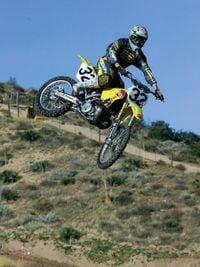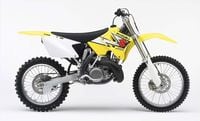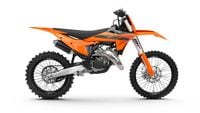Although our Long Haul RM250 got a vacation from the pages of this magazine, it didn't get a break from the track. After some staff changes, the Suzuki got passed along to test riders like Matt Armstrong and finally ended up in the hands of Chris Neitzel, who took it on the road and raced it during the summer while working as a riding coach for a group of fast mini racers. With a roughly estimated 50 hours on the bike at the time of the last update, it was freshened up with a top-end kit. The bike responded with a slight increase in snap. Amazingly, the clutch was still alive-a testament to the strict maintenance schedule, which included changing the tranny fluid quite regularly, or after almost every other ride. At about this time, the chain was truly shot, and it was replaced with a D.I.D 520MX Gold chain and a set of Tag Metals sprockets.We had a Pro Circuit top and bottom triple clamp on the bike, but a big crash wadded that and the ProTaper bar-all in all, a $700 wipeout. We put the stock triple clamp back on, added a Renthal bar and licked our wounds. It hurt worse in the wallet, but we were really lucky we didn't bend the fork.When we turned the bike over to Neitzel, it needed a thorough going-over as a lot of the big pieces, such as engine mounts, headset and swingarm pivots, were in need of grease and retightening. The bike was given a fresh clutch, and off Neitzel went. In Texas, the bike was raced at Oak Hill and Three Palms in its nearly stock form, and it kept ripping, even against the four-strokes it was facing. It carried Neitzel to some good results in the +25 pro class, and he isn't the lightest guy by any means. Those motos and a strict diet of practicing put 20 more hours on the bike by the time it came back to California. After a few more races and some practice while back home, the only thing it needed was some coolant every few rides. Then a misaligned air filter had the motor sucking sand, and you guessed it, the crank seized. Not only that, the sand rubbed everything above it to death.From there we called it a year, but not before we decided to see what it would take to get the RM back up to snuff. We tore it apart (something you'll see in a lot of our final Long Haul reports) to see how things really turned out. We knew the crank and top end were junk, but we wanted to see how all the other stuff fared. With the bike stripped down to nuts and bolts, here is what we noticed. Considering the number of riders on the RM and the general level of maintenance, meaning it was treated in a "not my bike" kinda way, the RM was in surprising shape. Except for the sand that went through it, the cylinder looked like it was still in fine condition. The head was so tidy that it cleaned right off with a rag and contact solvent. All of the chassis bearings still moved easily and had no play; they just needed grease. The wheels were not perfect but were mostly round and in good shape. The RM's plastic wasn't cracked and was in decent shape, though it is no longer like new. While the frame had no obvious cracks, it would benefit from paint touch-up around the peg mounts and the swingarm pivot area. Even the levers were in good shape, since they were replaced after the triple clamp-tweaking crash.The bad list was short. Most notably, the aluminum aftermarket shock rings were jammed on the shock body. No doubt it would require a new shock body to repair. As you would almost expect, the reeds were chipped on a couple of corners.And when we reassembled the motor, we did it the right way, the way a race mechanic would if he were putting it together for an event the next weekend. All the while, we noted how an average guy could "get by" if it was just a rebuild for another season of riding; the parts list reflects that option. The chassis was basically OK, but our race mechanic would have replaced a lot of the bearings just to give the bike a "brand-new" tight feel.After reassembly, we took the bike for one more spin for photos and to see just how this very one-year-old bike felt, especially compared to the tight 2006 machines we were out riding that day. Surprisingly, the Suzuki did better than expected. The RM's motor was as good, if not better than we remember the stock 2005 being. First, the Pro Circuit pipe really helps this '05, and second, since the motor was all-new in the top end and the tranny was super-broken-in, it ripped freely-for lack of a better description. The control and feel of the clutch were phenomenal, and the power just kept on pulling long into the top-end, further and harder than most RMs we've ridden. The shifting was as slick as ever. Everyone who rode our Long Haul bike thought this motor should be dropped into a brand-new chassis.That was because the chassis showed its age. We think a few new bearings and a lot of extra time repacking some of the looser ones would have helped the bike for sure, but the biggest issue is the suspension. From what we can deduce, the Showa pieces on the RM are asked to do a lot more work than similar components on a Honda. More leverage on the shock through the linkage and a steeper head angle that asks a lot of the fork meant the suspension felt loose despite the full service. That old complaint that it was blowing through the stroke was back. The MB1 settings were aimed at eliminating this, but it was also targeted for a lighter rider like Armstrong. It would only be a matter of time before the bike grew looser than we liked for our heavier guys. We've seen a very similar trend with our stock RMs over the last few years.Our Long Haul definitely showed that the Suzuki RM250 has improved in durability from just a few years ago. Back then, a season-old RM, ridden this hard, would be completely clapped-out. Ours was just a few bearings away from being really tight. As it sits now, this bike could just about go another season being ridden by pro-level riders, or it would be a great used machine for someone looking for a bargain and still have a long life ahead of it if used at a less than top level of performance.Running Tally
Hours on Bike: 80
Modification cost total: $1765.59
Maintenance and Repair: $1133.75 (not including tires)
Race Tools muffler packing: $18.95
12 tranny oil changes with Silkolene
competition gear oil: $12.99 per quart
silkolene pro cool: $8.99 per lite
Gasket kit: $66.22
Cylinder: $502
Top end kit: $115.89
Main bearings: $71.24
Reeds: $7.80
Clutch basket: $170.25
Fork seals: $30.08
Fork bushings: $21.42
2 Dunlop 742 front tires: $90.70 each
3 Dunlop 756 rear tires: $107.70 each
Latest

/cloudfront-us-east-1.images.arcpublishing.com/octane/3GF26TF5YVFIJCHZJMYTMWIPPY.jpg)
/cloudfront-us-east-1.images.arcpublishing.com/octane/QSWIPGJUFNAENBSGFG5ASKGUCY.jpg)
/cloudfront-us-east-1.images.arcpublishing.com/octane/JEB56YXHFZDYRBTQRSUPSIQT4E.jpg)
/cloudfront-us-east-1.images.arcpublishing.com/octane/2U42JYK7ZVCK5FISIIFYDLMFQY.jpg)


/cloudfront-us-east-1.images.arcpublishing.com/octane/2F2YWJRM4ZDCBEBIHI6HAZXI5U.jpg)


/cloudfront-us-east-1.images.arcpublishing.com/octane/I37LN27L3ZHRHO6DZRHHBLBCZQ.jpg)


/cloudfront-us-east-1.images.arcpublishing.com/octane/77ZEF3VNXZFIHI5IUF6ZBEHEJE.jpg)

/cloudfront-us-east-1.images.arcpublishing.com/octane/M5OFLO75LRBXXPXDVFIRIAKJWM.jpg)

/cloudfront-us-east-1.images.arcpublishing.com/octane/XFANREREUJHCTOV5UB2BJIQDOU.jpg)
/cloudfront-us-east-1.images.arcpublishing.com/octane/JDD3UJJOYNDKZH7G3REK676I3Y.jpg)
/cloudfront-us-east-1.images.arcpublishing.com/octane/WX7RDB74WNG4LEJX357DVYVDIU.jpg)
/cloudfront-us-east-1.images.arcpublishing.com/octane/MYU2ARUAFFGDTAPV6NOPY54CFY.jpg)
/cloudfront-us-east-1.images.arcpublishing.com/octane/7OY2GP3FWFEDVEMDSLNGM6PZRM.jpg)
/cloudfront-us-east-1.images.arcpublishing.com/octane/VDOEVSAFZRCVHEE4XZUNE3M5AE.jpg)
/cloudfront-us-east-1.images.arcpublishing.com/octane/VZK3FKU3PJA55PTTINHZ4GWLWQ.jpg)